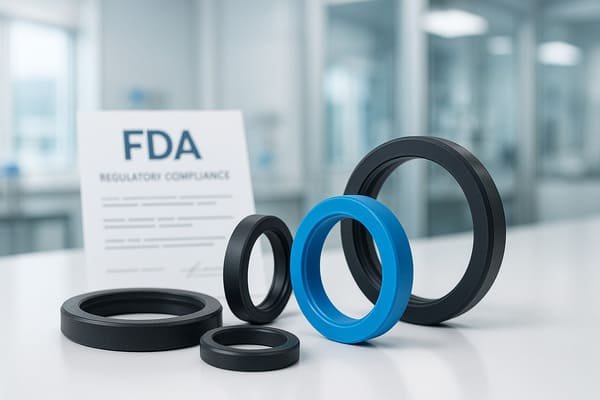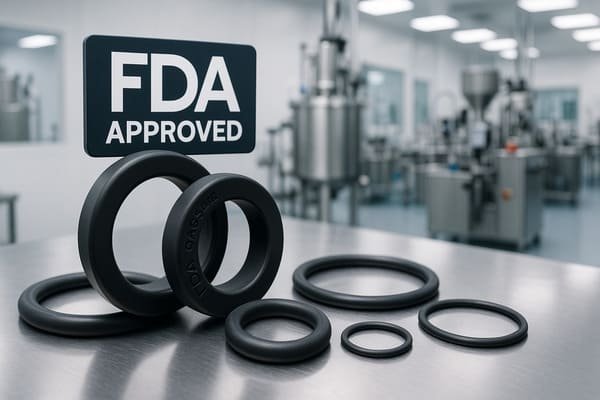When selecting materials for food, medical, or pharmaceutical applications, it's important to understand the difference between FDA-approved and FDA-compliant rubber parts. These terms might seem similar but have distinct meanings in terms of safety and regulatory standards.
FDA-approved rubber parts have passed rigorous testing to meet FDA standards for safety, while FDA-compliant rubber parts only adhere to relevant regulations without undergoing specific FDA testing.

Although both FDA-approved and FDA-compliant rubber parts are crucial for industries like food and pharmaceuticals, they serve different roles. Let’s explore the key differences, how each term affects material selection, and their implications for safety and regulatory adherence.
What Does FDA-Approved Mean?
FDA-approved rubber parts are those that have been directly tested and cleared by the U.S. Food and Drug Administration. But what does it mean for a rubber part to be FDA-approved?
FDA-approved rubber parts undergo specific testing to ensure they meet strict safety standards, making them safe for direct contact with food, medical products, and pharmaceuticals.
FDA approval1 means that the rubber material has been tested by the FDA for safety and efficacy. It is designed for direct contact with food, pharmaceuticals, or medical products. The FDA evaluates rubber materials based on various factors, including:
- Non-Toxicity: FDA-approved rubber parts are free from harmful substances and chemicals that could leach into food or medications.
- Biocompatibility: For medical and pharmaceutical applications, FDA-approved rubber must not cause adverse reactions when in contact with human tissues.
- Testing and Certification: FDA-approved materials undergo specific tests, such as migration tests, to determine if the rubber releases any harmful substances. These materials are then certified to ensure they meet the FDA's strict standards.
FDA-approved rubber parts provide the highest level of safety and reliability for sensitive applications, such as food processing and medical devices, where regulatory compliance is critical.
What Does FDA-Compliant Mean?
FDA-compliant rubber parts2 adhere to regulations that apply to materials used in food, medical, and pharmaceutical industries. But how does this differ from FDA-approved?
FDA-compliant rubber parts meet the general regulations and safety standards but have not necessarily undergone FDA-specific testing or certification.

FDA compliance means that the rubber material adheres to the broad requirements outlined by the FDA, but it may not have been specifically tested or cleared by the FDA. Compliance generally refers to meeting the following:
- Regulatory Standards: FDA-compliant rubber parts follow the guidelines outlined in the Federal Food, Drug, and Cosmetic Act (FFDCA) and other relevant regulations. These guidelines govern how materials interact with food and drugs.
- Indirect Contact: Rubber materials that are FDA-compliant may be used in applications that don’t involve direct contact with food or medical products. For instance, rubber used for packaging seals or gaskets may not undergo the same stringent testing as materials that are intended to be in direct contact.
- General Safety: Compliance ensures that rubber parts meet general safety requirements, such as being free from hazardous chemicals, but they may not have been tested for migration or other FDA-specific criteria.
FDA-compliant rubber parts are suitable for less sensitive applications but may not offer the same level of assurance as FDA-approved materials in terms of safety and testing.
Key Differences Between FDA-Approved and FDA-Compliant Rubber Parts
Now that we understand what FDA-approved and FDA-compliant rubber parts mean, let’s break down the key differences and how they impact material selection for your application.
FDA-approved rubber parts have passed rigorous testing by the FDA, ensuring the highest safety standards, while FDA-compliant parts meet general regulations but may not undergo the same level of testing.
Here’s a comparison of the key differences between FDA-approved and FDA-compliant rubber parts:
| Criteria | FDA-Approved Rubber Parts | FDA-Compliant Rubber Parts |
|---|---|---|
| FDA Testing | Tested by FDA for safety and migration properties. | May not undergo specific FDA testing. |
| Regulatory Standards | Meets strict FDA standards for direct food, medical, or pharmaceutical contact. | Follows general FDA regulations but not necessarily FDA-specific testing. |
| Safety Assurance | Highest level of safety assurance3 for sensitive applications. | Meets basic regulatory safety requirements. |
| Applications | Used in direct contact with food, medical products, and pharmaceuticals. | Used in indirect contact or less sensitive applications. |
FDA-approved rubber parts provide the highest level of assurance for safety, making them ideal for food and medical use. FDA-compliant rubber parts are sufficient for applications that do not require direct contact with food or pharmaceuticals.
Why Does FDA Approval Matter?
FDA approval is essential when safety is paramount. Let’s explore why FDA approval is important in selecting rubber materials for sensitive applications.
FDA approval provides the highest level of safety assurance, ensuring that the rubber material is safe for direct contact with food, medical products, or pharmaceuticals.

FDA approval ensures that a rubber material has been thoroughly tested and meets the safety standards necessary for use in sensitive applications. Here are some of the reasons why FDA approval matters:
- Direct Contact with Food and Medical Products: FDA approval is required for materials that come into direct contact with food or medical devices. It ensures that the material does not release harmful substances that could affect human health.
- Consumer Safety: FDA approval provides consumers and manufacturers with the confidence that the material is safe and meets rigorous standards for non-toxicity and biocompatibility.
- Regulatory Compliance: For industries regulated by the FDA, using FDA-approved materials is necessary to maintain compliance with federal safety regulations and avoid potential legal issues.
FDA-approved rubber parts are crucial in industries where safety and compliance are non-negotiable.
Conclusion
The key difference between FDA-approved and FDA-compliant rubber parts lies in the level of testing and certification. FDA-approved rubber materials have undergone rigorous testing to ensure they are safe for direct contact with food, medical products, and pharmaceuticals. FDA-compliant rubber materials adhere to general FDA regulations but may not undergo the same level of specific testing. Understanding these differences ensures that you choose the right rubber material for your application, whether it requires direct contact with sensitive products or general safety compliance.
🚀 Need Custom FDA Approved Rubber Parts?
Contact Julong Rubber today or Request a Custom Quote for high-quality FDA-approved rubber products tailored to your needs!
Or reach out to us directly via WhatsApp:

-
Understanding FDA approval is crucial for ensuring safety in food and medical applications. Explore this link for detailed insights. ↩
-
Learn about FDA-compliant rubber parts and their regulatory implications for safer applications. This resource will clarify your doubts. ↩
-
Safety assurance is vital for consumer trust and regulatory compliance. Discover more about its importance in this informative link. ↩








